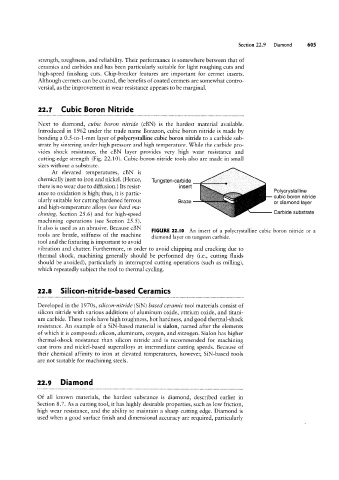Page 624 - 04. Subyek Engineering Materials - Manufacturing, Engineering and Technology SI 6th Edition - Serope Kalpakjian, Stephen Schmid (2009)
P. 624
Section 22.9 Diamond 605
strength, toughness, and reliability. Their performance is somewhere between that of
ceramics and carbides and has been particularly suitable for light roughing cuts and
high-speed finishing cuts. Chip-breaker features are important for cermet inserts.
Although cermets can be coated, the benefits of coated cermets are somewhat contro-
versial, as the improvement in wear resistance appears to be marginal.
22.7 Cubic Boron Nitride
Next to diamond, cubic boron nitride (CBN) is the hardest material available.
Introduced in 1962 under the trade name Borazon, cubic boron nitride is made by
bonding a 0.5 -to-1-mm layer of polycrystalline cubic boron nitride to a carbide sub-
strate by sintering under high pressure and high temperature. While the carbide pro-
vides shock resistance, the cBN layer provides very high wear resistance and
cutting-edge strength (Fig. 22.1O). Cubic-boron-nitride tools also are made in small
sizes without a substrate.
At elevated temperatures, cBN is
chemically inert to iron and nickel. (Hence, Tungstewcarbide
there is no wear due to diffusion.) Its resist- insert
ance to oxidation is high; thus, it is partic- Polycrystalline
cubic boron nitride
ularly suitable for cutting hardened ferrous Braze
or diamond layer
and high-temperature alloys (see /mm' ma-
Carbide substrate
chining, Section 25 .6) and for high-speed
machining operations (see Section 25.5 ).
It also is used as an abrasive. Because cBN
FIGURE 22.10 An insert of a polycrystalline cubic boron nitride or a
tools are brittle, stiffness of the machine diamond layer on tungsten Carbidn
tool and the fixturing is important to avoid
vibration and chatter. Furthermore, in order to avoid chipping and cracking due to
thermal shock, machining generally should be performed dry (i.e., cutting fluids
should be avoided), particularly in interrupted cutting operations (such as milling),
which repeatedly subject the tool to thermal cycling.
22.8 Silicon-nitride-based Ceramics
Developed in the 1970s, silicon-nitride (SiN) based ceramic tool materials consist of
silicon nitride with various additions of aluminum oxide, yttrium oxide, and titani-
um carbide. These tools have high toughness, hot hardness, and good thermal-shock
resistance. An example of a SiN-based material is sialon, named after the elements
of which it is composed: silicon, aluminum, oxygen, and nitrogen. Sialon has higher
thermal-shock resistance than silicon nitride and is recommended for machining
cast irons and nickel-based superalloys at intermediate cutting speeds. Because of
their chemical affinity to iron at elevated temperatures, however, SiN-based tools
are not suitable for machining steels.
22.9 Diamond
Of all known materials, the hardest substance is diamond, described earlier in
Section 8.7. As a cutting tool, it has highly desirable properties, such as low friction,
high wear resistance, and the ability to maintain a sharp cutting edge. Diamond is
used when a good surface finish and dimensional accuracy are required, particularly

